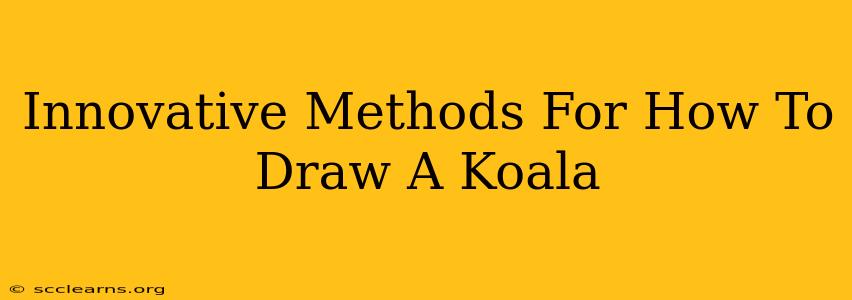Drawing a koala might seem straightforward, but achieving a truly captivating and realistic portrayal requires innovative techniques. This guide explores methods beyond the basic shapes, focusing on capturing the unique texture and charm of these adorable marsupials. We'll move beyond simple tutorials and delve into how to create truly stunning koala artwork.
Understanding Koala Anatomy: The Foundation of a Great Drawing
Before diving into techniques, let's understand the essentials. A koala's anatomy isn't just about round shapes; it's about subtle curves and proportions. Observe reference images closely. Note:
- The Head: A rounded head with prominent, rounded ears. Pay attention to the placement of the eyes – slightly lower and more towards the center than you might initially think.
- The Body: A compact, slightly pear-shaped body. The shoulders are broader than the hips.
- The Limbs: Thick, powerful limbs perfect for clinging to eucalyptus trees. The hands and feet are especially important; observe their unique structure.
- The Fur: Thick, plush fur is key to a realistic koala. Consider how the fur flows and creates shadows.
Innovative Drawing Techniques: Beyond the Basics
Here's where we move beyond simple "how to draw a koala" guides and into more sophisticated methods:
1. Value Studies & Shading Techniques for Realistic Fur
Forget flat coloring! Mastering value (light and shadow) is crucial for creating realistic fur. Try these techniques:
- Hatching and Cross-Hatching: Use closely spaced parallel lines (hatching) or intersecting lines (cross-hatching) to build up texture and depth. Vary line pressure for a more natural look.
- Scumbling: A loose, sketchy application of shading using a dry brush or charcoal, creating a soft, furry effect.
- Blending Techniques: Smooth transitions between light and shadow are essential. Experiment with blending stumps, tortillons, or your fingers for seamless shading. This is especially effective for the koala's plush fur.
2. Negative Space Drawing: A Unique Approach
Instead of focusing solely on the koala's outline, try drawing the space around the koala. This negative space drawing technique helps you understand the shapes and proportions more accurately, leading to a more natural-looking drawing.
3. Layering Textures: Capturing the Koala's Unique Coat
Koalas have surprisingly complex fur. Don't just shade it uniformly! Experiment with layering different textures to represent the variations in fur length and density. Consider using different drawing tools – pencils, charcoal, even pastels – to achieve this effect.
4. Using Different Media: Exploring Beyond Pencil
Expand your artistic horizons! Experiment with various media to capture different aspects of the koala:
- Charcoal: Ideal for capturing the dark tones and shadows of the fur.
- Watercolor: Great for creating a soft, flowing effect, capturing the fluidity of the fur.
- Colored Pencils: Allows for precise detail and the ability to blend colors seamlessly.
Mastering the Details: Eyes, Nose, and Paws
The smaller details are where your drawing will truly shine.
- Eyes: Koala eyes are small and expressive. Pay attention to the subtle highlights and shadows that bring them to life.
- Nose: The small, black nose is a key feature. Pay attention to its shape and placement.
- Paws: The koala's hands and feet are unique. Study reference images carefully to capture their shape and the way they grip branches.
Practice and Patience: The Key to Success
Drawing a realistic koala takes practice. Don't get discouraged if your first attempts aren't perfect. The more you practice using these innovative techniques, the better you'll become at capturing the essence of these captivating creatures. Remember to use various reference images and experiment with different styles to find your unique approach. Your artistic journey is about continuous learning and improvement.

